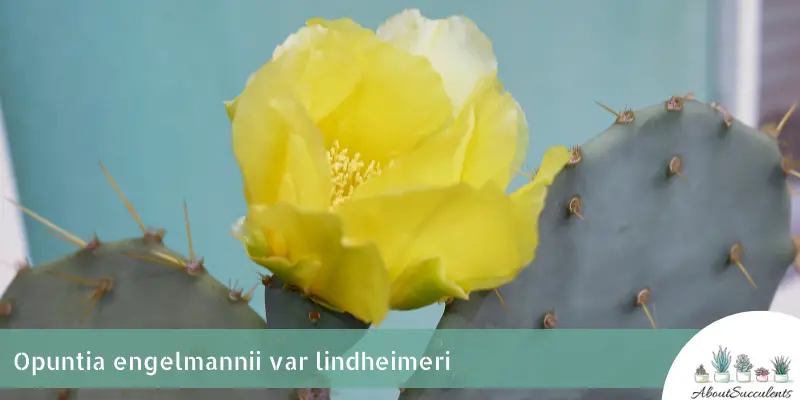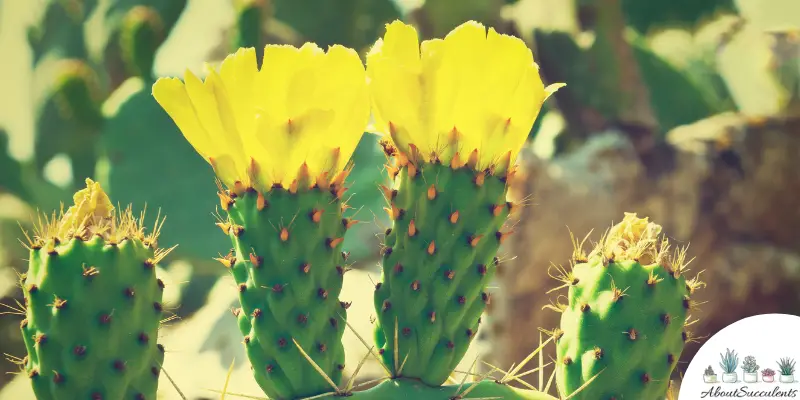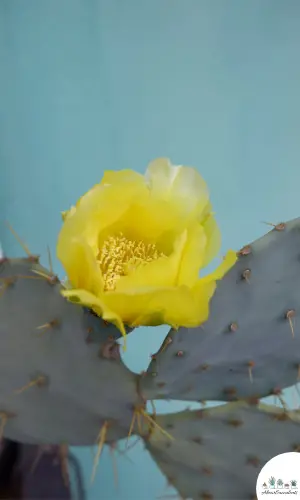
Opuntia Engelmannii var Lindheimeri also known as Texas Prickly Pear is a distinct-looking cactus with flat pear-shaped pads which are segmented evergreen stems.
The pads, also known as nopales, are 8 to 12-inches (20.32 to 30.48cm) long and are covered with long sharp spines which are actually leaves that hardened over time.
The fleshy green pads are edible only after all the spines and tufts are removed. This towering cactus bears deep red or purple, juicy, sweet seasonal fruits called pears or tunas. These edible fruits turn ripe for picking during midsummer.
The Texas Prickly Pear grows up to 8-feet (2.4m) wide and 5-feet (1.5m) tall. It blooms orange or yellow flowers in April through June. The flowers are good-sized at 2 to 4-inches (5.08 to 10.16cm).
Opuntia Engelmannii var Lindheimeri is grown best outdoors because of its prickly spines and height. It can also be grown indoors, in a conservatory, or a heated greenhouse.
The Prickly Pear cactus is native to Arizona, California, New Mexico, Nevada, New Mexico, Oklahoma, and Texas, USA. It is part of the Opuntia genus from the Cactaceae family.
General Information
Also known as: Texas Prickly Pear and Lindheimer Prickly Pear
Plant Family: Cactaceae
Origin: Arizona, California, New Mexico, Nevada, New Mexico, Oklahoma, and Texas, USA
Height: 3-6 ft
Exposure: Full sun or partial shade; avoid the afternoon sun
Water Needs: Drought-tolerant; water the soil only when it’s completely dry
Soil Type: Cactus mix combined with gritty materials such as perlite, pumice, coarse sand, or lava rock
Soil pH: 6 to 7.5
How to Grow and Care for Opuntia Engelmannii var Lindheimeri

The robust-looking Opuntia Engelmannii var Lindheimeri can be easily grown outdoors where it can bask under the sun. It can also be grown indoors in potted containers away from children and pets.
The Texas Prickly Pear is not a cold-hardy cactus. It cannot survive temperatures below -12° C (10° F). If you live in an area with extremely cold weather, it’s best to plant your Prickly Pear cactus in a container so you could move it indoors during winter.
Sunlight
Plant your Opuntia Engelmannii var Lindheimeri in an area where it could get at least 6 hours of full or filtered sun every day. If potted indoors, place it near a south- or west-facing window.
When a cactus plant does not get enough light, its stems will curl up as if stretching out to find the light. Make sure that your cactus plant is located in an area where it gets enough dose of sunlight to prevent etiolation. Otherwise, the pads will become pale, thin, and tubular.
Watering

The Texas Prickly Pear is drought-tolerant and can survive without water for days. Overfeeding it with water can cause root rot that will lead to its early demise.
Use the ‘soak and dry’ watering method to prevent bacteria and molds from breeding in the soil. This method involves drenching the soil with water and waiting for the soil to fully dry out before watering again. To test the soil’s dryness, insert a stick into the soil or use a moisture sensor.
Watering your cacti and succulents properly will make them happy and healthy. Make sure to check your plant regularly so you will be well aware of its condition and develop a good sense of its needs. If you are a new succulent grower, it is best to write down your watering schedule.
Water your potted Texas Prickly Pears less during summer and keep the soil moist during winter.
Pot and Soil
Opuntia engelmannii var lindheimeri will grow best in terracotta or unglazed ceramic pots. They are made with porous materials that allow proper soil aeration and prevent moisture retention.
When buying a pot for your cactus, choose one that is 10% wider in diameter than the plant. For example, if your Prickly Pear is 4 inches in diameter, get a pot that is 5 inches wide.
Cacti do not like damp soil so make sure to get pots with drainage holes. The Texas Prickly Pear grows best in a cactus soil mix or free-draining compost. To improve the quality of drainage, add water filtering materials such as perlite, pumice, lava rocks, or coarse sand.
Opuntia engelmannii var lindheimeri requires no fertilizer if it is planted outdoors. If potted, it will require feeding from spring to fall because the soil’s nutrients get depleted faster.
Feed a baby cactus with a balanced fertilizer, one that has a balanced ratio of nitrogen, phosphorus, and potassium. For grown plants, use a 0-15-0 no-nitrogen fertilizer to have more flowers and fruits. If you want your plant to bear more pads, use a nitrogen-rich fertilizer.
How To Propagate Opuntia Engelmannii var Lindheimeri
Opuntia Engelmannii var Lindheimeri can be propagated by using its pads/stems or seeds. The best time to propagate by stem/pad cuttings is during spring or early summer while seeds are best planted in late spring.
Stem/Pad Cuttings Method
Step 1: Wear thick gloves and long sleeves to protect your hands and arms from the sharp spines and skin-irritating glochids.
Step 2: Gently pull the pads from the main plant or use a sterile knife or shears to cut them off. Always use a sterile and sharp cutting tool to prevent infection of the cut area.
Step 3: Place all the pads in a dry and shaded area. Leave them there for a few days or until the wounds heal or callus.
Step 4: Fill terracotta pots with cactus soil combined with gritty materials. Choose pots that are wider than your pads. Insert each pad (calloused side down) into the soil.
Step 5: Place the pots in an area exposed to filtered bright light. Do not water your Prickly Pears until they show signs of growth.
Seeds
Step 1: Fill a seed tray with cactus soil. Soak the soil and drain it.
Step 2: Gently rub the seeds on sandpaper to remove the seed coat and help speed up germination. Sow the seeds in the seed tray and make sure there’s a 1-inch space in between the seeds. If you are using small pots, plant one seed in each pot.
Step 3: Press the seeds into the soil and cover them with a thin layer of soil. Lightly mist the soil and cover the containers with a plastic cover. Punch small holes on the cover to allow air to circulate.
Step 4: Put the seed tray or pots in a sunny area. Mist the soil until seedlings appear.
Frequently Asked Questions
Is Opuntia Engelmannii var Lindheimeri Toxic For Cats And Dogs?
Opuntia Engelmannii var Lindheimeri is listed as non-toxic to cats and dogs on the website of the American Society for the Prevention of Cruelty to Animals (ASPCA).
Why Is My Opuntia Engelmannii var Lindheimeri Dying?
Texas Prickly Pears are low-maintenance cacti. However, you need to check it regularly for signs of unwellness. Early intervention will prevent your cactus from dying which is caused by the following:
Overwatering
Drought-tolerant plants are highly susceptible to root rot. If the roots are kept in a moist environment for a long period of time, their cells can rupture.
In addition, overwatering your plant results in damp, heavy soil which is the favorite breeding ground of fungi. Once the cells rupture, the roots become vulnerable.
Discoloration in the leaves or stems is a telltale sign of infection. Treat your cactus immediately when the pads turn yellowish gray and the base of the plant turns mushy. You can save its life by repotting it.
Remove the plant from the pot and brush off the soil from the roots. Cut the damaged roots and stems with a sterilized and sharpened pair of garden scissors or a knife.
Leave the plant in a cool and dry area. Fill your pot with fresh cactus soil and sand. Repot your cactus and wait for a few days before you water it.
Pest Infestation
The Texas Prickly Pears are prone to mealybugs and scale infestation. These pests suck plant juices resulting in shriveled pads. Severe infestation can kill your cactus.
To remove mealybugs and scale by spraying the plant with diluted alcohol or neem oil. Treat your plant once a week until the pests are gone.
During the treatment, quarantine the infected plant to prevent the pests from contaminating other plants.
Yes, it blooms orange and yellow flowers that measure 2 to 4-inches (5.08 to 10.16cm) in spring and summer.
Last Updated on June 9, 2022 by Sofia Lara